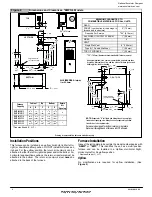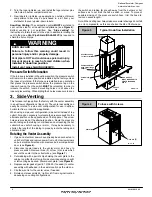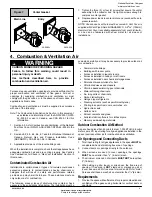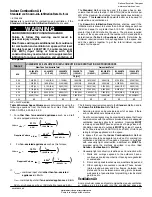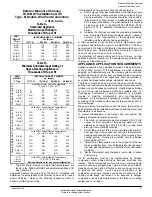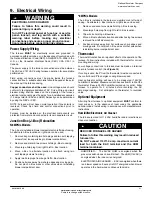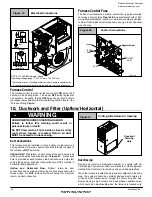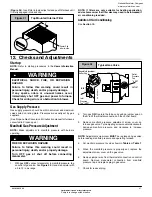
12
441 01 2613 05
Specifications are subject to change without notice
replacement air. Whichever method is used, the mixed return air
temperature across the heat exchanger
MUST
not fall below 60
°
F
(16
°
C)
continuously, or 55
°
F(13
°
C) on an intermittent basis so
that flue gases will not condense excessively in the heat
exchanger. Excessive condensation will shorten the life of the heat
exchanger and possibly void your warranty.
5. Gas Vent Installation
CARBON MONOXIDE POISONING, FIRE AND
EXPLOSION HAZARD
Failure to follow this warning could result in
personal injury, death, and/or property damage.
Read and follow all instructions in this section.
!
WARNING
Install the vent in compliance with codes of the country having
jurisdiction, local codes or ordinances and these instructions.
This Category
I
furnace is fan
!
assisted.
Category
I
furnace definition: A central furnace which operates
with a non
!
positive vent static pressure and with a flue loss not
less than 17 percent. These furnaces are approved for
common
!
venting and multi
!
story venting with other fan
!
assisted
or draft hood
!
equipped appliances in accordance with the NFGC
or NSCNGPIC
Category
I
Safe Venting Requirements
Category
I
furnace vent installations shall be in accordance with
Parts 12 and 13 of the National Fuel Gas Code (NFGC), ANSI
Z223.1/NFPA 54
!
2009; and/or Section 8 and Appendix C of the
CSA B149.1
!
05, National Standard of Canada, Natural Gas and
Propane Installation Code; the local building codes; furnace and
vent manufacturer’s instructions.
NOTE
: The following instructions comply with the ANSI
Z223.1/NFPA 54
!
2009 National Fuel Gas Code and CSA B149.1
Natural Gas and Propane Installation code, based on the input
rate on the furnace rating plate.
1. If a Category
I
vent passes through an attic, any concealed
space or floor, use
ONLY
Type B or Type L double wall vent
pipe. If vent pipe passes through interior wall, use Type B vent
pipe with ventilated thimble
ONLY
.
2. Do
NOT
vent furnace into any chimney serving an open
fireplace or solid fuel burning appliance.
3. Use the same diameter Category
I
connector or pipe as
permitted by:
•
the
National Fuel Gas Code
Code ANSI Z223.1/ NFPA
54
!
2009 Sections 12 and 13 venting requirements in the
United States
or
•
the National Standard of Canada
Natural Gas and
Propane Installation Code
(NSCNGPIC) CSA
B149.1
!
05 Section 8 and appendix C venting
requirements in Canada.
4. Push the vent connector onto the furnace flue collar of the
venter assembly until it touches the bead [at least
5
/
8
″
(15.9mm) overlap] and fasten with at least two field
!
supplied,
corrosion
!
resistant, sheet metal screws located at least 140
°
apart.
5. Keep vertical Category
I
vent pipe or vent connector runs as
short and direct as possible.
6. Vertical outdoor runs of Type
!
B or
ANY
single wall vent pipe
below the roof line are
NOT
permitted.
7. Slope all horizontal runs up from furnace to the vent terminal a
minimum of
1
/
4
″
per foot (10mm/m).
8. Rigidly support all horizontal portions of the venting system
every 6
′
or less using proper clamps and metal straps to
prevent sagging and ensure there is no movement after
installation.
9. Check existing gas vent or chimney to ensure they meet
clearances and local codes. See
Figure 1
10. The furnace
MUST
be connected to a factory built chimney or
vent complying with a recognized standard, or a masonry or
concrete chimney lined with a lining material acceptable to the
authority having jurisdiction.
Venting into an unlined
masonry chimney or concrete chimney is prohibited. See
the 6.
Masonry Chimney Venting
section in these
instructions.
11. Fan
!
assisted combustion system Category
I
furnaces shall
not be vented into single
!
wall metal vents.
12. Category
I
furnaces must be vented vertically or nearly
vertically, unless equipped with a listed mechanical venter.
13. Vent connectors serving Category I furnaces shall not be
connected into any portion of mechanical draft systems
operating under positive pressure.
Venting and Combustion Air Check
NOTE
: When an existing Category I furnace is removed or
replaced, the original venting system may no longer be sized to
properly vent the attached appliances, and to make sure there is
adequate combustion air for all appliances,
MAKE THE
FOLLOWING CHECK.
Vent Check
Draft Hood
Vent Pipe
Match
Typical Gas
Water Heater
Figure 9
NOTE:
If flame pulls towards draft hood, this indicates
sufficient infiltration air.
National Excelsior Company
www.excelsiorhvac.com
Subject to change without notice.






